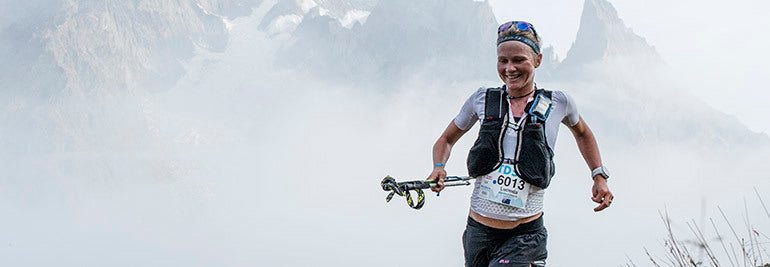

Suunto Blog

Lucy Bartholomew on how to almost quit... then not
Ultra-runner Lucy Bartholomew is known for a few things: being an up-and-coming young gun on the distance scene, her constant grin, and of course, “bein’ ‘Strayan”. (That’s ‘being Australian’, in case you couldn’t figure it out.) After this year’s UTMB weekend, she’ll be known for another thing: comebacks. After contemplating a voluntary DNF just 30kms into the 120km TDS race at UTMB weekend, Lucy found a spark and picked up 25 female places, finishing the last 7km at a blazing 4:00/km pace, and taking 5th place overall for women.
“I was having some tummy issues early one in the race – and I just couldn’t get anything down. Water, food, gels – the second I brought it up to my lips I felt nauseous, and anything I forced down was just coming back up,” she says. Not long after the six A.M. start, Bartholomew was forced to walk a 15km downhill – which, as any runner can tell you, is a poor place to be losing time. “I think the extra jolting of the downhill just upset my stomach even more,” she said.
It was a shame – Bartholomew had been in Chamonix training and doing reccy for four weeks prior to the race, and she was coming off an impressive finish in the Mont Blanc 80, taking an unexpected 2nd place. The TDS route – more remote, with fewer aid stations, and more vertical per kilometer than UTMB – was to her liking. So coming off the downhill, she was going slowly and just waiting for her support – in fact, her dad who was also in the race – to catch her. “He probably would have told me to stop,” she says. What kept her going? Knowing what was coming – she’d done a proper three-day reccy before the race, giving her a solid overview of the entire course. “I think that helped – knowing what was ahead, no surprises.” And now? “Now I’m kind of glad he never drove by – it was something I needed to get through myself – and I learned a lot about myself out there.”
Nine hours into the race, she managed to get a shot block down her throat, and it stuck. “I’ve never been hit so hard by the sugar in my life,” says Bartholomew. “I think it was because I was just so empty. It really gave me a jolt and let me get back in the race.” She started passing racers, eventually roaring into town at the afore-mentioned speed, passing her last female competitor just 400 yards before the finish line.
While Bartholomew was still ‘disappointed’, the rest of us can agree: it was impressive display of resilience for the young runner. Now that it’s over, what’s in the plans? Lucy is happy to be home – and of course – more running. “It feels like I never left Australia – pretty happy to get back to my routine.” Potential upcoming races include the Ultra Trail Ning Hai in China – she’s not sure if she’ll do the 50 or the 100 – and the Capetown 100 in South Africa.
Next year, she might venture on to American soil. “I’d love to do the Hard Rock,” she says, “but I know people who have waited to get in [via lottery] for eight years!” Definitely not on the list? The Barkley Marathons or anything like it – navigation is not her game. “If it’s not on my Suunto watch, I’m not running – I’m not tough enough for that!”
Images by Damien Rosso / Droz Photo

Ryan Sandes achieved his dream. How? He worked (and raced) smart
It was Ryan's third attempt at the legendary race in California, but after getting blown off the line by upstart Jim Walmsley, Sandes’ persistent pace put him on track to grab first place. Now that he’s had eight weeks to recover, run a few more fun ones, and start thinking about next year, we caught up to learn what we could – though we highly recommend watching the video below to hear some of Ryan’s story in his own words.
Sandes went faster by slowing down. (Image by Kelvin Trautman, Red Bull Content Pool)What was different this year? In some ways – Sandes went faster by slowing down. 2015 was rough – he contracted Glandular Fever, a viral infection known for lingering. He later realized that illness was part of the beginning stages of overtraining. As he began working back in 2016, there was something else: Ryan became Papa Ryan. You don’t need to be a family man yourself to know what kind of toll that takes on serious athletic training. In other words: it was hardly the perfect scenario to make a big push at one of the hardest races in the world. But long ago – back before he’d ever run his first Western States – South African running legend Bruce Fordyce sent Ryan a note, and addressed it: “To a future Western States champion”. Suffice it to say Ryan had a goal. How to approach it? “I did a little less training than before,” says Ryan. “More focused and more specific.” His Suunto Spartan Ultra was an important training partner – running trail, it’s tough to keep track of effort using just distance and time, so elevation gain and loss was one of the most important things he paid attention too. Going into the event, much of the pre-race hype was about upstart Jim Walmsley – who’s enjoyed a meteoric (and boastful) rise to ultra-running elite status. Jim thought he could set a course record in 2016 – and famously made a wrong turn at mile 92. He was back again in 2017. “Heading out on to the course, I asked Jim if he was still going to go for under 14,” says Ryan. “He said, ‘yeah baby!’ and took off. At that point I held back.” Sandes was at one point almost an hour behind Walmsley, ‘running his own race’ as he puts it. But as Sandes kept going through checkpoints, word began to trickle back: Walmsley was slowing down. “I respect him for trying it!” says Ryan. “It takes balls to even make an attempt like that.”
A dream comes true. (Image by Corinna Halloran, Red Bull Content Pool)Then he got reports that Jim had even sat down early in the race. Then Ryan made up 17 minutes over just eight kilometers. At the next station he was right on his heels. Finally, he passed Walmsley, and held on for a win at Western States, the grand-daddy of all ultra-marathons.
Since then he’s had some fun – he took part in the Burro Racing World Championships – and also entered a serious race, the CCC at UTMB weekend in Chamonix. Legs still tired, he finished, but in a disappointing-to-him 21st place – although to anyone in the know, finishing at all is pretty impressive. Up next: a project he doesn’t want to talk too much about – stating only that it’s high altitude and far away – and next year’s big goal: UTMB, a race that’s only been won once by a non-European (and that winner came from Nepal.) Can he win it? He’ll have to train smart again – “I think you really need to spend time in that environment, so you’re used to racing in that environment” – but in ultra-running, the human body itself proves anything is possible. In the meantime? Rest, rest and more rest – because rest works.
Main image © Kelvin Trautman / Red Bull Content Pool
Watch this video about Ryan's Western States 100 experience

Is the ultimate cross-training… breathing? Mike Maric teaches athletes to breath better
Tell us a bit about your dive history.
I was a free diver and still am a free diver. I was lucky enough to meet the legendary Umberto Pelizzari, and not long after joined his entourage for trainings, travels and world records. I began to free dive professionally myself in the early 2000s, and my career took me to underwater all over the world. But in 2005 tragedy struck when my best friend died during a dive.
What happened next?
After that, I stepped back from competitive diving and began to work more as a trainer and safety diver. I continued my studies in the medical field, and then eventually I began to put my medical competence to use as a free diver.
Tell us more.
I work very specifically with breathing and breathing technique, with the goals of improving performance and reducing recovery times. Essentially, we’re helping athletes increase their oxygen supply, and teaching their muscles to work better without oxygen. We work specifically with the diaphragm to have more oxygen. Then next is to be master of your breath. To be more conscious about have more air.
Mike Maric working with Trek Segafredo pro cycling team (©Trek-Segafredo)
To be more conscious? That sounds like a mind game…
Absolutely. Science shows us it’s not physical, but mental – apnea technique is really important, but we also know mental is really important! My students really learn how to improve the mental conditions and discover new limits inside of themselves!
And now your work includes lots of people who don’t dive and don’t intend to.
Everyone in the world can benefit from better breathing techniques! Over the last few years I’ve been working with many athletes from different disciplines – beginning with triathletes, but now including martial arts masters, fencers, and more. I’ve even helped an oncologist who uses the techniques with his cancer patients.
How do you help a world champion in fencing?
The first goal in fencing or karate is to relax before the performance – reduce the stress and lower the heartbeat. The second is to reduce the recovery time. In fencing, for instance, world Paolo Pizzo is going full-speed for 30 seconds, then rest. During that rest time he moves his shoulders, breathes in a specific way, and recovers very quickly. The first time he did that, a lot of people wondered what he was doing – but it works.
How do you use your Suunto?
The Spartan is an extremely important tool for me – I use it to see breath frequency and heart rate.
Medically educated forensic scientist Mike Maric has taken what he’s learned from free diving and applied it to a multitude of other sports.
How can you help amateur athletes?
There are for sure some simple exercises to be conscious about your breathing. When I ask people ‘how do you breath?’ they don’t know! They know about shoes and running, they know about eating, they know about supplements! But they don’t know how they breath! We need to breath not with the chest, but with the diaphragm! But you need to practice continuously – the basics, about eight minutes each day. That’s enough time to improve over six weeks – although it’s different for each athlete.
No yoga.
Ha! I don’t do yoga. I back up medically sound advice with scientific evidence. Better breathing can improve your mental condition, increase performance, and decrease stress. That’s science!
For more info on Mike Maric's work visit mikemaric.com

What’s tougher: running the Barkley Marathons… or training for it?
But as we approach the Barkley’s off-season, let’s take a look not at the race – but the training. Soon Robbins will release a short film detailing his Barkley experience – in anticipation, he’s shared a short piece focused on an incredibly difficult full overnight session where the goal was to reach 20,000ft (6,100m) of climbing in around 11 hours. See how his session unfolds – then keep reading for some more insight into his ‘off-season’.
Watch this advanced preview of Where Dreams Go To Die documentary now.
If this video doesn’t make your legs hurt, then this will: Robbins just finished the Nolan’s Fourteeners, fourteen 14,000 peaks in 100 miles, with a 60-hour cut-off time. Less than 20 people have ever completed the route.
A post shared by Gary Robbins (@garyrobbins) on Jul 31, 2017 at 10:24am PDT
"Adventures were had, and we got it done. Nolan's 14 finishers in 56h39m, with the best adventure partner imaginable." –@garyrobbins
We’ve collected some of Gary's thoughts and feelings on the recent adventures, what’s upcoming, and what’s not just worth the time (hint: hypoxic training). Read on.
You didn’t have the easiest time on Nolan’s!
After trudging through fourteen plus hours of fog, wind and rain we found ourselves hypothermic and in a bad state. We actually had some snow flurries on Oxford (8th peak going south to north) and we realized we couldn't safely continue. We made the hard call to drop off the mountain and to call it a day. We skipped Belford (maybe one mile away) because of the state we were in. We dropped about five miles down to a trailhead and had our families and crew meet us there. After warming up and being reminded by my lovely wife that we still had 31 hours left to get this done we made the call to get back in the game. We turned around and headed all the way back up to the saddle we'd dropped off maybe five hours earlier.
Nolan’s Fourteeners are like a Barkley, with less vertical but way more altitude…
Exactly. It’s only been done a handful of times. I’ll be coming straight from sea level into that! But we had access to our support crew – we can check in six or seven times over the course of the traverse.
The altitude is the biggest issue.
Yeah – I live at the coast. But my partner in the coaching business studies this stuff – he says I have to spend 12 hours a day in a hypoxic chamber if I want any benefit from it. No time for that!
You have a few events of your own you’re organizing.
I run a race series back home and I’ve got events before and after the Nolan’s attempt. The biggest is the Squamish 50 – it’s the biggest ultra in Canada, with 1200 participants from 20 countries.
Do you compete in them yourself?
I just don’t have the time. I want to make sure it’s a great event for everyone who comes. I don’t run in the events because I need to run the event – I congratulate every finisher who comes across the line. During the Squamish 50 I’ll get about 8 hours of sleep over three days.
You’re an organizer with some epic terrain close by. Any chance we’ll see a race like the Barkley, in your backyard?
You know, we have the terrain for it – it could rival the Barkley on paper. But it’s damn near impossible to get the permits, and I don’t feel the need to replicate something so unique that Laz has created.
Take us back to your recent adventure on Nolan’s – how did you finish?
It rained for another 10+ hours up high but eventually the weather broke, before it broke us, and we were rewarded with a clear night on our third to last peak (La Plata) and a beautiful sunrise while ascending our second to last peak, the highest point in Colorado, Mt. Elbert at 14,433. I shed a tear on our final peak, Mt. Massive because I really couldn't believe what we'd just accomplished. It wasn't what we'd set out to do time wise, and I'm pretty sure we just completed the least scenic version of Nolan's ever, but the sense of accomplishment that overwhelms me today is the absolute definition of euphoria.
So there’s no question you’re doing Barkley again.
I’m 100% returning for a third attempt in 2018.
Main image and video by The Ginger Runner

Three ways to navigate with a Suunto Spartan GPS watch
Jeff Pelletier, a trail runner and filmmaker from Vancouver, BC, Canada put together this great video with some tips for navigating with the Suunto Spartan. He showcases how you can navigate in new surroundings or challenging terrain using these three different features of the Spartan.
1. Routes
2. Compass
3. Breadcrumb
Watch the video now!
You are not limited to these three ways to navigate. You can also use POI navigation (read how this is done here). In addition, as of the Spartan update in June (1.9.36) you can now also use find back navigation which plots your quickest route back to your starting point utilizing the compass to guide you.
Main image by @jpelletier
Learn more about Suunto Spartan GPS watches

Meet the 21-year-old woman on a six-year running high
I ran my first 100km when I was 16 just one year after I started running
Yep, I went from 0 to 100 in one year at age 16. It’s my dad’s fault. His name is Ashley. It was his second 100k. He’d been running marathons, and once realized he wouldn’t get faster, he decided to go longer. The race was the Surf Coast century.
I’ve run six 100ks since.
And more 50ks than I can even remember. I do them in training – I'll just head out for an afternoon 50. I did three weekends in a row of just 50k runs.
I didn’t love running at the start.
I thought it was hard! Then there I was running a 50k, back to back to back every weekend. It’s amazing what you can do.
But now I’ve been running for six years non-stop.
I started running, and I just did so many easy kilometers with my dad. I built this base very naturally, not forced. Now that I have the base I can do the harder training sessions. I have six years of non-stop running. That’s a big base no matter how old you are.
What I love most is the places I go and the people I meet.
If you didn’t have the people in this sport that were so raw and so organic, it would be a completely different sport. The places you go is really exciting but the people you meet keep you competing.
I want to do the Hard Rock 100
Just because it’s so hard to get into. Transvulcania. And some of that are totally off the grid – ones I don’t even know about, in really cool locations.
I always have a plan, and I never follow it.
I’m pretty reactive and pretty in tune with my body. I’m totally OK with missing a training session or going day by day. I always have a plan but I very rarely follow it. My racing style is not aggressive – I would say I’m someone who eases into it. I start slow and finish strong.
My toughest race? World Sky Running Champs 2016
It was a marathon in Catalonia. I had never seen terrain quite like it. A lot of scree and skiing down scree slopes. I really struggled with it. But I finished the race.
I’m so glad I’m 21...
So I was able to run my last big event: The Marathon du Mont Blanc, 80km of trail in Chamonix. It was the first time I could run the race – because I’m finally 21 years old. But the big goal of the year is the TDS as part of the UTMB weekend.
…but I was a little terrified to start my last race!
I’m a big fish in a small pond in Australia. Now it feels like I’m stepping up to the big leagues. It’s very leveling and I’m a small fish in a big pond – the talent and level is amazing. And more importantly, we just don’t have terrain like this in Australia. I was a bit terrified for my last race! I didn’t have enough time to run every section – only the first climb and last climb, and a few sections in between.
It was 80km.. then 85km… then 92km
The race is called the Marathon du Mont Blanc 80km. They told us the actual course was 85km. Then they modified it to get us more water – but that came with an extra 500m climb and seven more kilometers.
I had a great start, a tough middle section, and strong finish
I felt pretty tired coming into Chamonix, and almost didn’t start the race. The first three hours were great, the next four were terrible, then I hit the halfway point and started counting down the K’s and picking off ladies as I moved up field. I finished in 13h23m, twenty minutes behind 1st place, in a tight battle for 2nd place – I was only a minute ahead of 3rd!
It’s an honor to be a young gun
I know a lot of people are watching me and saying 'maybe it’s safe to start that early.' It’s really exciting to inspire other young runners.
Images by Damien Rosso / Droz Photo














































































